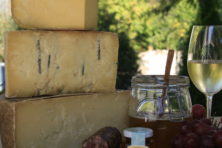The Cheese Insider
- Share
- Tweet
- Pin
- Share
Ask any cheesemaker what beverage “pairs” best with cheese and they will say: beer.
Beer is one of the oldest beverages humans have produced, with evidence of beer trade and brew recipes dating as far back as the Sumerians in 2050 B.C. The European immigrants that settled in Wisconsin brought with them a love for both beer and cheese, and it wasn’t long after arriving that breweries and cheese plants were being built throughout the state.
The larger brewers in Wisconsin were mostly German and they built their breweries in Milwaukee – Schlitz, Pabst, Blatz, and Miller made Milwaukee the “Beer Capital of the USA.” Large breweries were also built in LaCrosse, Stevens Point, Monroe, Madison, and many other cities and towns throughout the state.
During the same time the breweries were being built, the dairy industry was being shaped by the Swiss and other European settlers. Farms were sprouting up all over, especially in the southern part of Wisconsin where the rich, fertile soils left by the glaciers made it ideal for farming. As the dairy industry grew, it spurred on the growth of cheese plants; nearly every four corners of roads in southern Wisconsin had a cheese plant. The transportation of milk from the farm to the cheese plant was done with milk cans and horse drawn wagons, and most farmers did not have to haul their bounty more than a mile or two to reach a cheese plant. You will still see the remnants of many of these small cheese plants spread throughout the state, almost always on a rural four corner intersection.
Today, the number of cheese plants has shrunk to very few, replaced by larger, modern plants. The same thing has happened to the dairy farmer. The smaller farms with 20 to 60 cows are going away, replaced by larger farms with herds in excess of 8,000 cows.
The number of artisan cheesemakers and craft brewers in this state, however, has grown tenfold during the past several years, as the artisan/craft food and beverage movement has taken hold. People are beginning to want to know where their food and drink comes from, and Wisconsin is leading the way.
Beer and cheese have a natural affinity. In fact, they are almost the same thing. They both start with grass: barley and wheat for beer, and actual grass in the case of cheese. Milking animals, such as cows, goats, and sheep, are often fed the spent grains leftover from making beer. Beer and cheese share similar flavors: nutty, tangy, floral, and earthy. They can both offer a sharp, dry texture or a smooth and creamy one. Beer and good cheese can complement each other with delightful contrasts: the sweetness of some beers is an ideal foil for cheese’s saltiness. And beer’s carbonation/bubbles work to whisk away the mouth-coating richness of cheese.
Next time you visit with your cheesemonger ask him/her what pairs well with the cheese you are interested in buying, or tell them what beer you have and ask for suggestions as to which cheese to pair it with.
Michael C. Thomas is co-owner of Schoolhouse Artisan Cheese with his wife Janice. With locations in Ellison Bay and Egg Harbor, they aim to bring the best of Wisconsin artisan cheeses to Door County, and with “The Cheese Insider” Michael hopes to bring all things cheese to readers of the Pulse.



